Operations Management in Decision Making: McDonald's, MGMT6003, Report
VerifiedAdded on 2023/06/09
|18
|3876
|137
Report
AI Summary
This report provides a comprehensive analysis of McDonald's operations management, focusing on the key components that drive decision-making and contribute to its value chain. The introduction sets the stage by highlighting the importance of operations management in today's competitive global economy, emphasizing the role of IT in streamlining processes. The report then delves into McDonald's specific operations, examining components such as planning, organizing, directing, and controlling. It illustrates how these functions contribute to the creation of value within the organization. Furthermore, the report explores quantitative methods used in operations management, including optimization modeling for process planning, network analysis tools (PERT/CPM) for scheduling, and Economic Order Quantity (EOQ) for inventory management. The analysis underscores the significance of these quantitative techniques in enabling effective decision-making within the organization. Finally, the report outlines the role of operations management in strategic management and supply chain optimization, offering a holistic view of how McDonald's integrates these elements to achieve operational excellence.
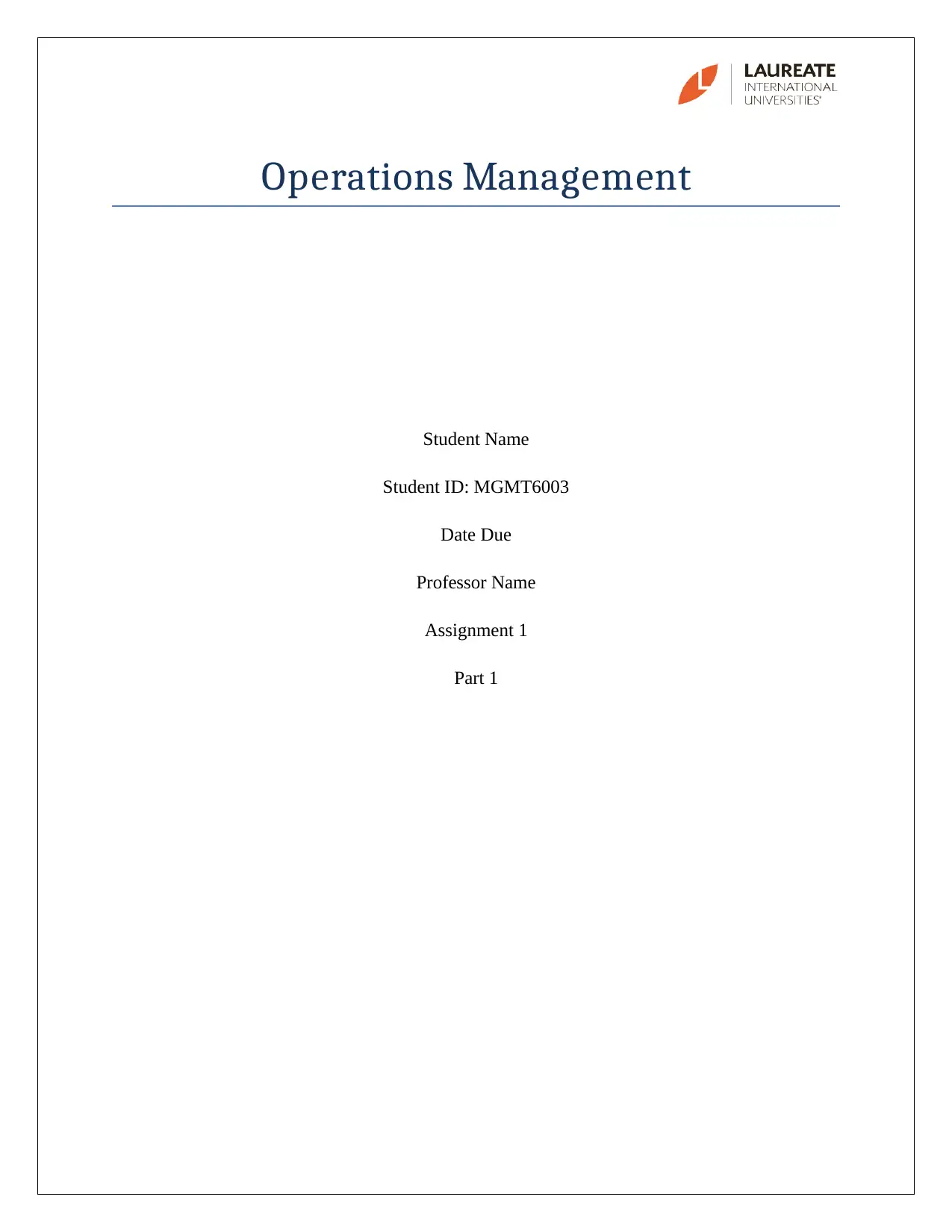
Operations Management
Student Name
Student ID: MGMT6003
Date Due
Professor Name
Assignment 1
Part 1
Student Name
Student ID: MGMT6003
Date Due
Professor Name
Assignment 1
Part 1
Paraphrase This Document
Need a fresh take? Get an instant paraphrase of this document with our AI Paraphraser
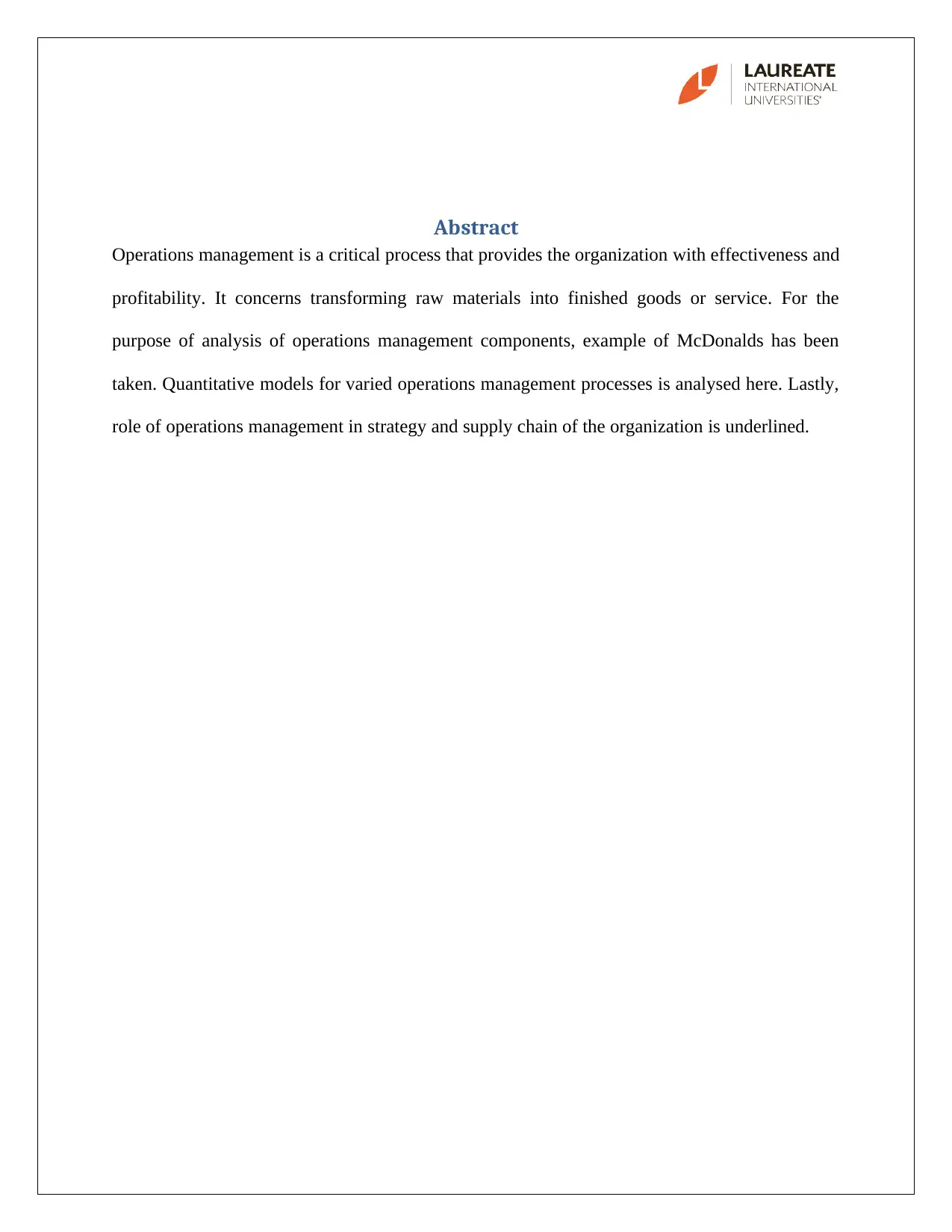
Abstract
Operations management is a critical process that provides the organization with effectiveness and
profitability. It concerns transforming raw materials into finished goods or service. For the
purpose of analysis of operations management components, example of McDonalds has been
taken. Quantitative models for varied operations management processes is analysed here. Lastly,
role of operations management in strategy and supply chain of the organization is underlined.
Operations management is a critical process that provides the organization with effectiveness and
profitability. It concerns transforming raw materials into finished goods or service. For the
purpose of analysis of operations management components, example of McDonalds has been
taken. Quantitative models for varied operations management processes is analysed here. Lastly,
role of operations management in strategy and supply chain of the organization is underlined.
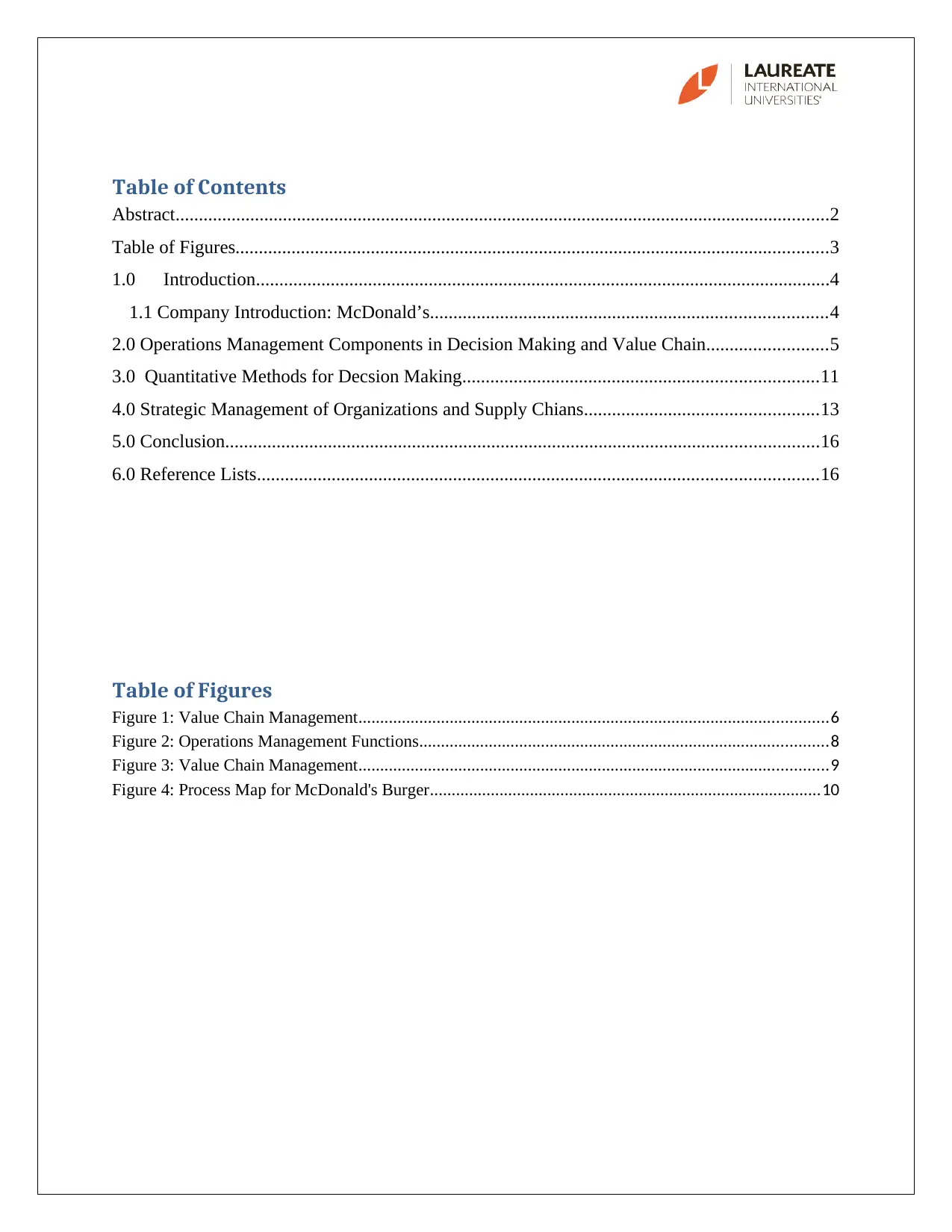
Table of Contents
Abstract............................................................................................................................................2
Table of Figures...............................................................................................................................3
1.0 Introduction...........................................................................................................................4
1.1 Company Introduction: McDonald’s.....................................................................................4
2.0 Operations Management Components in Decision Making and Value Chain..........................5
3.0 Quantitative Methods for Decsion Making............................................................................11
4.0 Strategic Management of Organizations and Supply Chians..................................................13
5.0 Conclusion...............................................................................................................................16
6.0 Reference Lists........................................................................................................................16
Table of Figures
Figure 1: Value Chain Management............................................................................................................6
Figure 2: Operations Management Functions..............................................................................................8
Figure 3: Value Chain Management............................................................................................................9
Figure 4: Process Map for McDonald's Burger..........................................................................................10
Abstract............................................................................................................................................2
Table of Figures...............................................................................................................................3
1.0 Introduction...........................................................................................................................4
1.1 Company Introduction: McDonald’s.....................................................................................4
2.0 Operations Management Components in Decision Making and Value Chain..........................5
3.0 Quantitative Methods for Decsion Making............................................................................11
4.0 Strategic Management of Organizations and Supply Chians..................................................13
5.0 Conclusion...............................................................................................................................16
6.0 Reference Lists........................................................................................................................16
Table of Figures
Figure 1: Value Chain Management............................................................................................................6
Figure 2: Operations Management Functions..............................................................................................8
Figure 3: Value Chain Management............................................................................................................9
Figure 4: Process Map for McDonald's Burger..........................................................................................10
⊘ This is a preview!⊘
Do you want full access?
Subscribe today to unlock all pages.

Trusted by 1+ million students worldwide
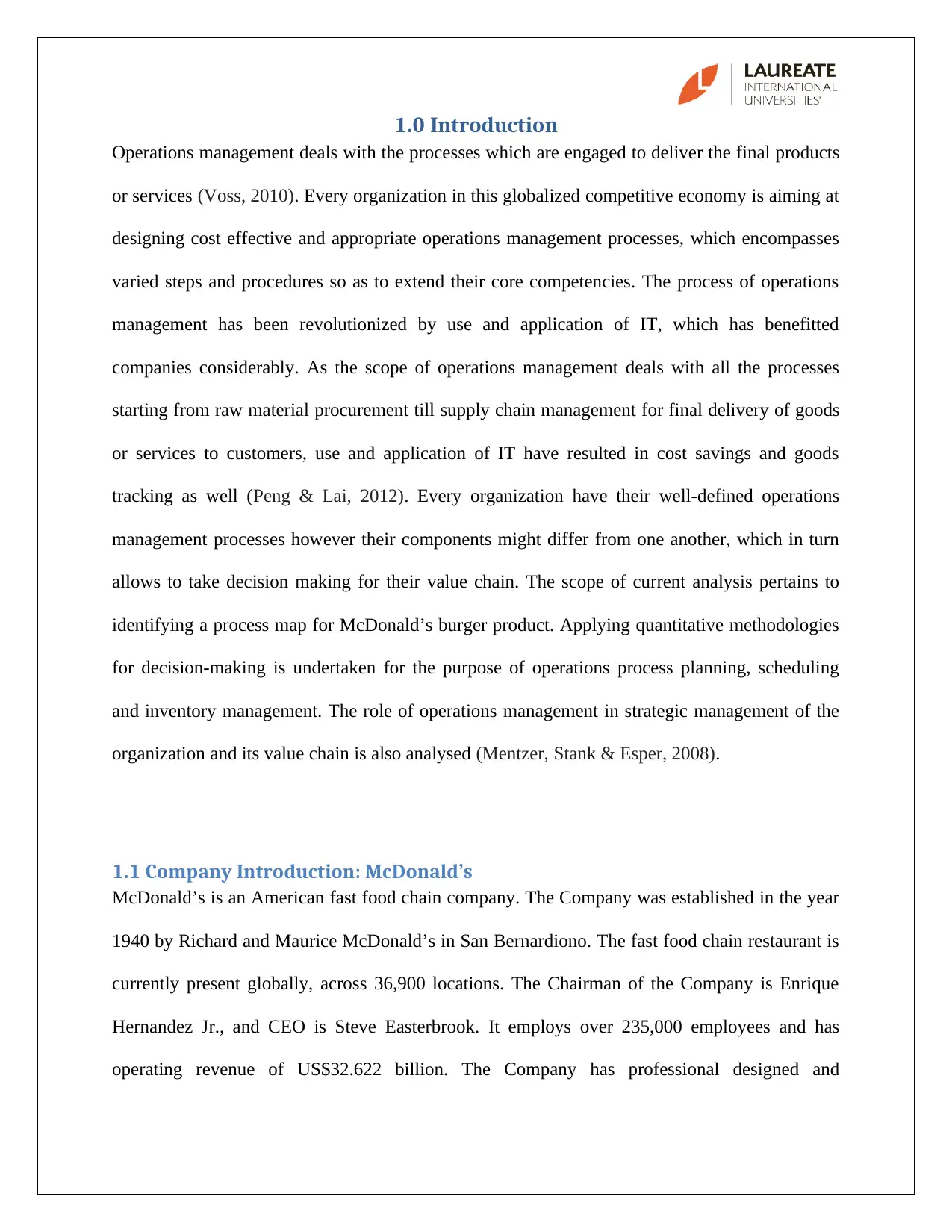
1.0 Introduction
Operations management deals with the processes which are engaged to deliver the final products
or services (Voss, 2010). Every organization in this globalized competitive economy is aiming at
designing cost effective and appropriate operations management processes, which encompasses
varied steps and procedures so as to extend their core competencies. The process of operations
management has been revolutionized by use and application of IT, which has benefitted
companies considerably. As the scope of operations management deals with all the processes
starting from raw material procurement till supply chain management for final delivery of goods
or services to customers, use and application of IT have resulted in cost savings and goods
tracking as well (Peng & Lai, 2012). Every organization have their well-defined operations
management processes however their components might differ from one another, which in turn
allows to take decision making for their value chain. The scope of current analysis pertains to
identifying a process map for McDonald’s burger product. Applying quantitative methodologies
for decision-making is undertaken for the purpose of operations process planning, scheduling
and inventory management. The role of operations management in strategic management of the
organization and its value chain is also analysed (Mentzer, Stank & Esper, 2008).
1.1 Company Introduction: McDonald’s
McDonald’s is an American fast food chain company. The Company was established in the year
1940 by Richard and Maurice McDonald’s in San Bernardiono. The fast food chain restaurant is
currently present globally, across 36,900 locations. The Chairman of the Company is Enrique
Hernandez Jr., and CEO is Steve Easterbrook. It employs over 235,000 employees and has
operating revenue of US$32.622 billion. The Company has professional designed and
Operations management deals with the processes which are engaged to deliver the final products
or services (Voss, 2010). Every organization in this globalized competitive economy is aiming at
designing cost effective and appropriate operations management processes, which encompasses
varied steps and procedures so as to extend their core competencies. The process of operations
management has been revolutionized by use and application of IT, which has benefitted
companies considerably. As the scope of operations management deals with all the processes
starting from raw material procurement till supply chain management for final delivery of goods
or services to customers, use and application of IT have resulted in cost savings and goods
tracking as well (Peng & Lai, 2012). Every organization have their well-defined operations
management processes however their components might differ from one another, which in turn
allows to take decision making for their value chain. The scope of current analysis pertains to
identifying a process map for McDonald’s burger product. Applying quantitative methodologies
for decision-making is undertaken for the purpose of operations process planning, scheduling
and inventory management. The role of operations management in strategic management of the
organization and its value chain is also analysed (Mentzer, Stank & Esper, 2008).
1.1 Company Introduction: McDonald’s
McDonald’s is an American fast food chain company. The Company was established in the year
1940 by Richard and Maurice McDonald’s in San Bernardiono. The fast food chain restaurant is
currently present globally, across 36,900 locations. The Chairman of the Company is Enrique
Hernandez Jr., and CEO is Steve Easterbrook. It employs over 235,000 employees and has
operating revenue of US$32.622 billion. The Company has professional designed and
Paraphrase This Document
Need a fresh take? Get an instant paraphrase of this document with our AI Paraphraser
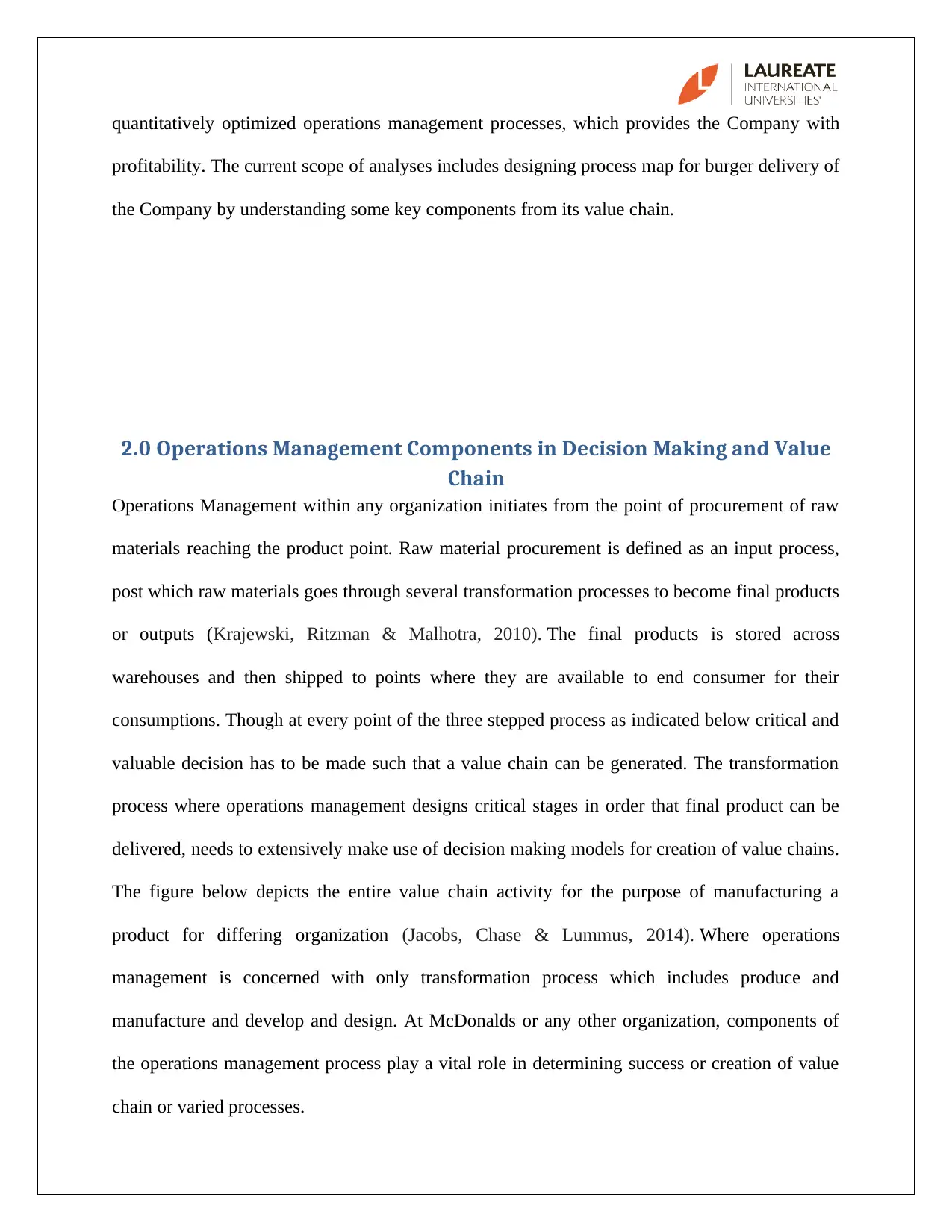
quantitatively optimized operations management processes, which provides the Company with
profitability. The current scope of analyses includes designing process map for burger delivery of
the Company by understanding some key components from its value chain.
2.0 Operations Management Components in Decision Making and Value
Chain
Operations Management within any organization initiates from the point of procurement of raw
materials reaching the product point. Raw material procurement is defined as an input process,
post which raw materials goes through several transformation processes to become final products
or outputs (Krajewski, Ritzman & Malhotra, 2010). The final products is stored across
warehouses and then shipped to points where they are available to end consumer for their
consumptions. Though at every point of the three stepped process as indicated below critical and
valuable decision has to be made such that a value chain can be generated. The transformation
process where operations management designs critical stages in order that final product can be
delivered, needs to extensively make use of decision making models for creation of value chains.
The figure below depicts the entire value chain activity for the purpose of manufacturing a
product for differing organization (Jacobs, Chase & Lummus, 2014). Where operations
management is concerned with only transformation process which includes produce and
manufacture and develop and design. At McDonalds or any other organization, components of
the operations management process play a vital role in determining success or creation of value
chain or varied processes.
profitability. The current scope of analyses includes designing process map for burger delivery of
the Company by understanding some key components from its value chain.
2.0 Operations Management Components in Decision Making and Value
Chain
Operations Management within any organization initiates from the point of procurement of raw
materials reaching the product point. Raw material procurement is defined as an input process,
post which raw materials goes through several transformation processes to become final products
or outputs (Krajewski, Ritzman & Malhotra, 2010). The final products is stored across
warehouses and then shipped to points where they are available to end consumer for their
consumptions. Though at every point of the three stepped process as indicated below critical and
valuable decision has to be made such that a value chain can be generated. The transformation
process where operations management designs critical stages in order that final product can be
delivered, needs to extensively make use of decision making models for creation of value chains.
The figure below depicts the entire value chain activity for the purpose of manufacturing a
product for differing organization (Jacobs, Chase & Lummus, 2014). Where operations
management is concerned with only transformation process which includes produce and
manufacture and develop and design. At McDonalds or any other organization, components of
the operations management process play a vital role in determining success or creation of value
chain or varied processes.
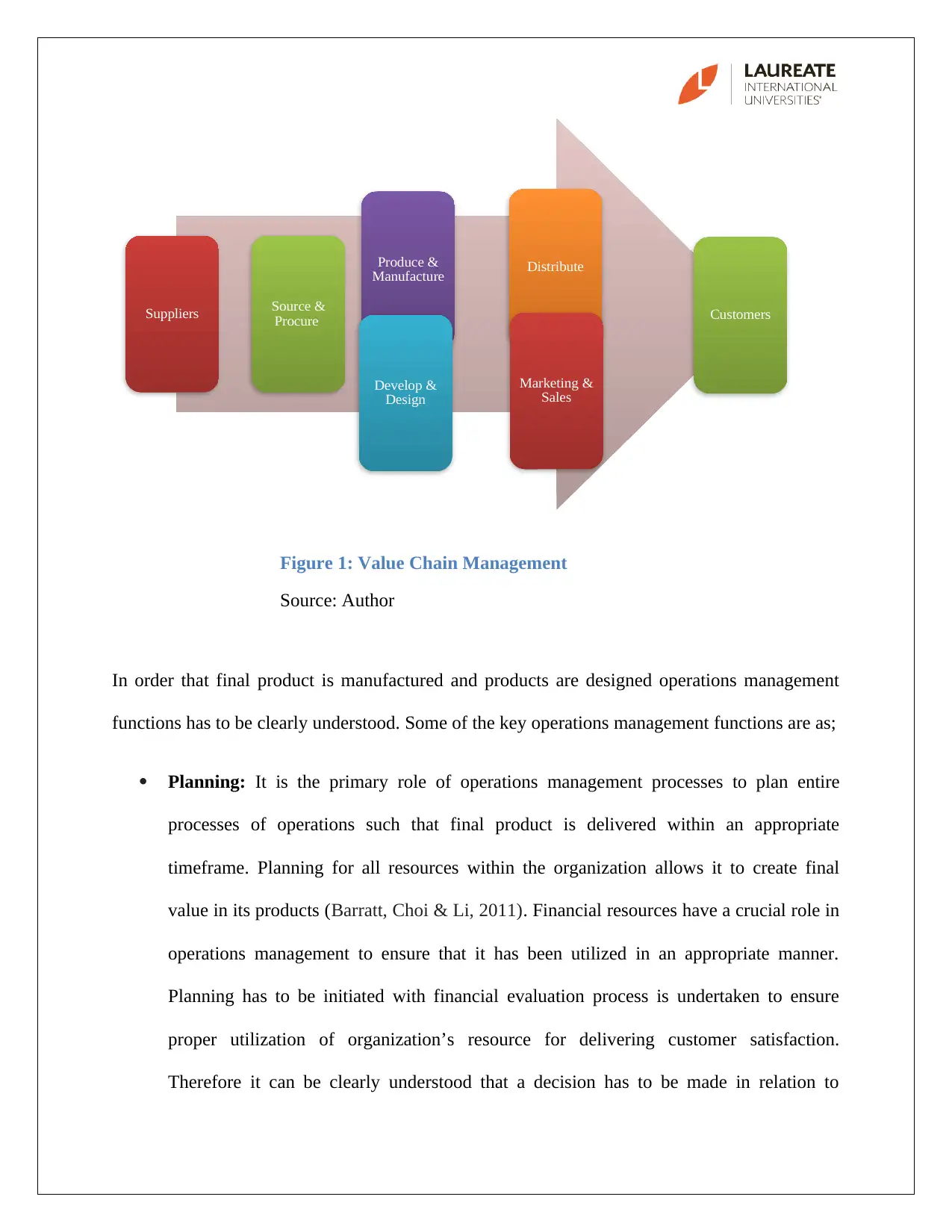
Figure 1: Value Chain Management
Source: Author
In order that final product is manufactured and products are designed operations management
functions has to be clearly understood. Some of the key operations management functions are as;
Planning: It is the primary role of operations management processes to plan entire
processes of operations such that final product is delivered within an appropriate
timeframe. Planning for all resources within the organization allows it to create final
value in its products (Barratt, Choi & Li, 2011). Financial resources have a crucial role in
operations management to ensure that it has been utilized in an appropriate manner.
Planning has to be initiated with financial evaluation process is undertaken to ensure
proper utilization of organization’s resource for delivering customer satisfaction.
Therefore it can be clearly understood that a decision has to be made in relation to
Suppliers Source &
Procure
Produce &
Manufacture
Develop &
Design
Distribute
Marketing &
Sales
Customers
Source: Author
In order that final product is manufactured and products are designed operations management
functions has to be clearly understood. Some of the key operations management functions are as;
Planning: It is the primary role of operations management processes to plan entire
processes of operations such that final product is delivered within an appropriate
timeframe. Planning for all resources within the organization allows it to create final
value in its products (Barratt, Choi & Li, 2011). Financial resources have a crucial role in
operations management to ensure that it has been utilized in an appropriate manner.
Planning has to be initiated with financial evaluation process is undertaken to ensure
proper utilization of organization’s resource for delivering customer satisfaction.
Therefore it can be clearly understood that a decision has to be made in relation to
Suppliers Source &
Procure
Produce &
Manufacture
Develop &
Design
Distribute
Marketing &
Sales
Customers
⊘ This is a preview!⊘
Do you want full access?
Subscribe today to unlock all pages.

Trusted by 1+ million students worldwide
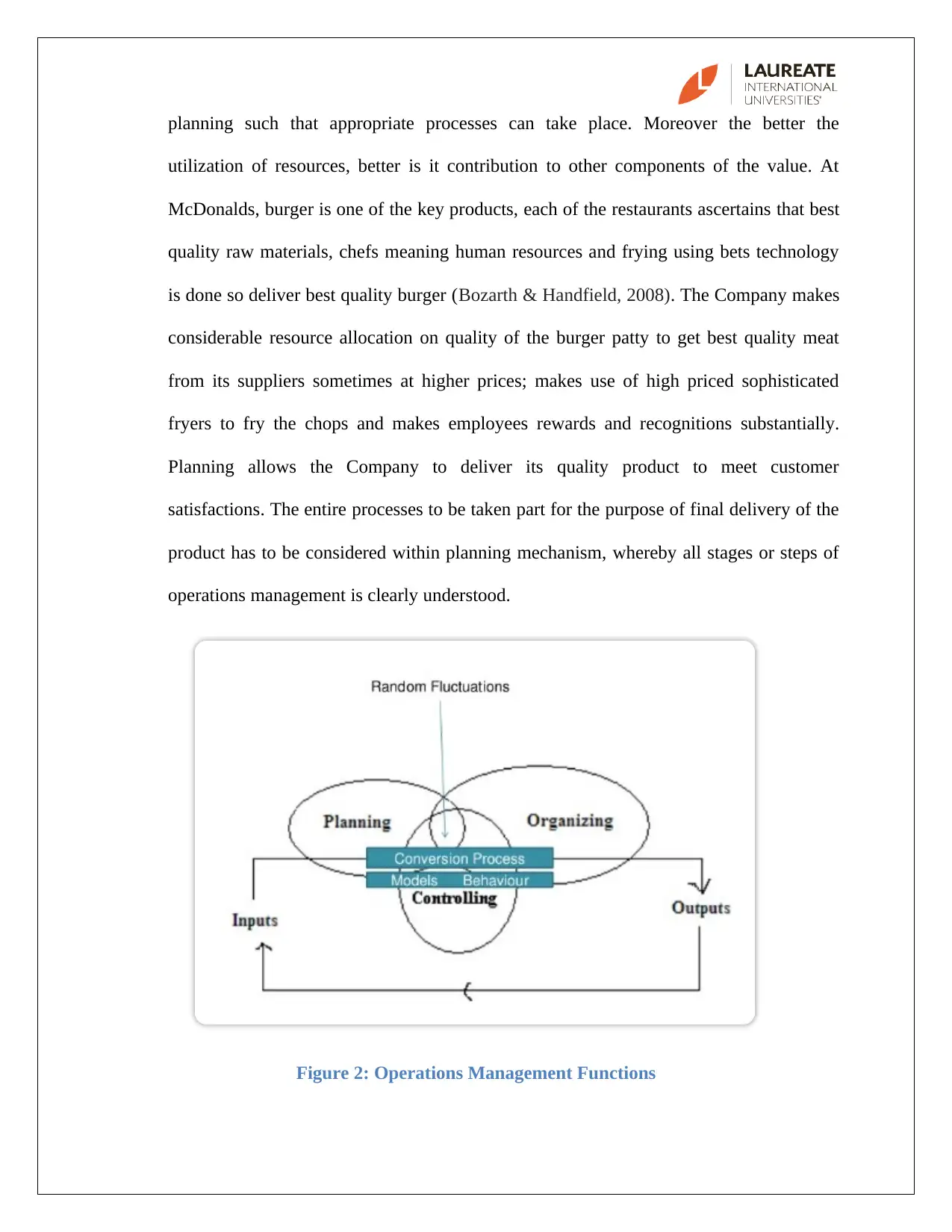
planning such that appropriate processes can take place. Moreover the better the
utilization of resources, better is it contribution to other components of the value. At
McDonalds, burger is one of the key products, each of the restaurants ascertains that best
quality raw materials, chefs meaning human resources and frying using bets technology
is done so deliver best quality burger (Bozarth & Handfield, 2008). The Company makes
considerable resource allocation on quality of the burger patty to get best quality meat
from its suppliers sometimes at higher prices; makes use of high priced sophisticated
fryers to fry the chops and makes employees rewards and recognitions substantially.
Planning allows the Company to deliver its quality product to meet customer
satisfactions. The entire processes to be taken part for the purpose of final delivery of the
product has to be considered within planning mechanism, whereby all stages or steps of
operations management is clearly understood.
Figure 2: Operations Management Functions
utilization of resources, better is it contribution to other components of the value. At
McDonalds, burger is one of the key products, each of the restaurants ascertains that best
quality raw materials, chefs meaning human resources and frying using bets technology
is done so deliver best quality burger (Bozarth & Handfield, 2008). The Company makes
considerable resource allocation on quality of the burger patty to get best quality meat
from its suppliers sometimes at higher prices; makes use of high priced sophisticated
fryers to fry the chops and makes employees rewards and recognitions substantially.
Planning allows the Company to deliver its quality product to meet customer
satisfactions. The entire processes to be taken part for the purpose of final delivery of the
product has to be considered within planning mechanism, whereby all stages or steps of
operations management is clearly understood.
Figure 2: Operations Management Functions
Paraphrase This Document
Need a fresh take? Get an instant paraphrase of this document with our AI Paraphraser
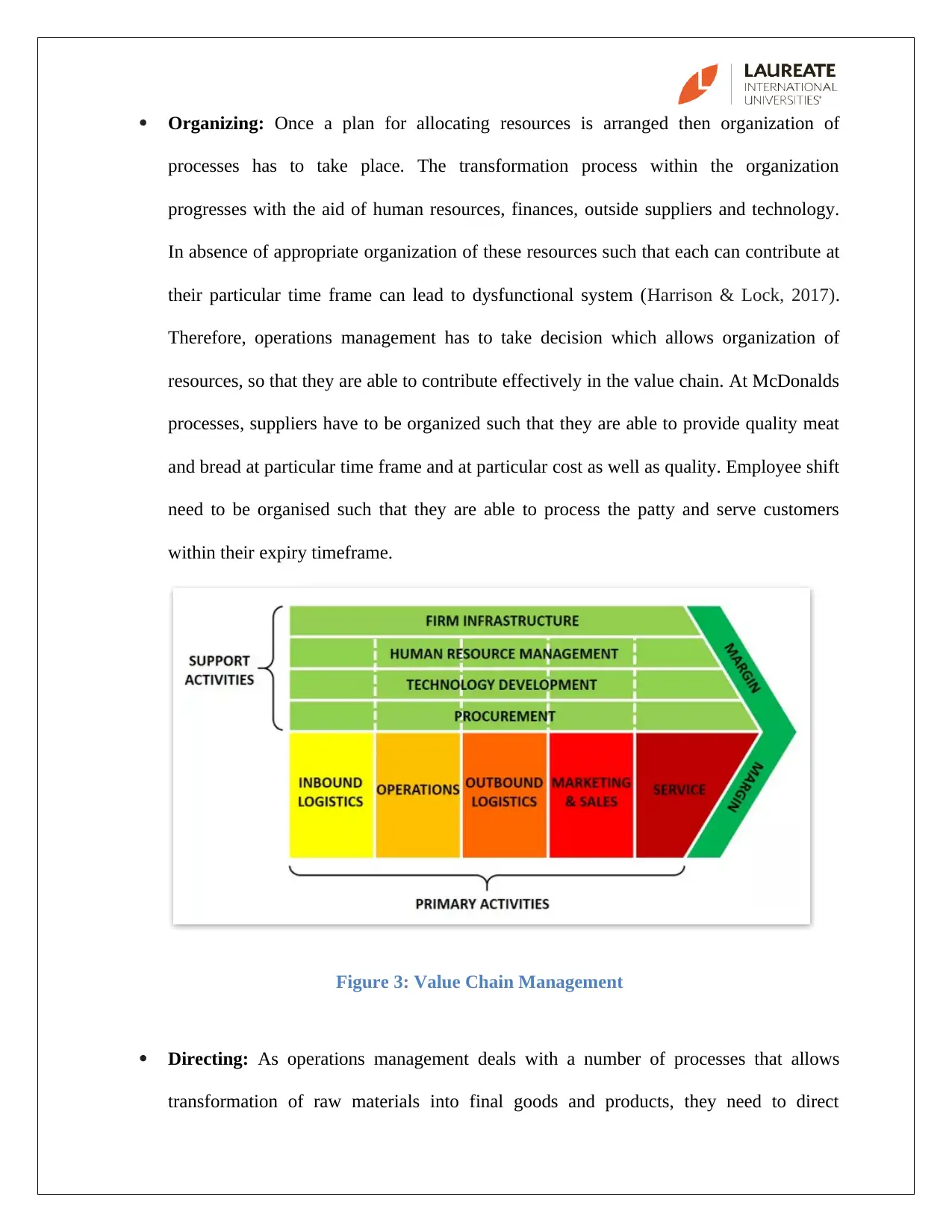
Organizing: Once a plan for allocating resources is arranged then organization of
processes has to take place. The transformation process within the organization
progresses with the aid of human resources, finances, outside suppliers and technology.
In absence of appropriate organization of these resources such that each can contribute at
their particular time frame can lead to dysfunctional system (Harrison & Lock, 2017).
Therefore, operations management has to take decision which allows organization of
resources, so that they are able to contribute effectively in the value chain. At McDonalds
processes, suppliers have to be organized such that they are able to provide quality meat
and bread at particular time frame and at particular cost as well as quality. Employee shift
need to be organised such that they are able to process the patty and serve customers
within their expiry timeframe.
Figure 3: Value Chain Management
Directing: As operations management deals with a number of processes that allows
transformation of raw materials into final goods and products, they need to direct
processes has to take place. The transformation process within the organization
progresses with the aid of human resources, finances, outside suppliers and technology.
In absence of appropriate organization of these resources such that each can contribute at
their particular time frame can lead to dysfunctional system (Harrison & Lock, 2017).
Therefore, operations management has to take decision which allows organization of
resources, so that they are able to contribute effectively in the value chain. At McDonalds
processes, suppliers have to be organized such that they are able to provide quality meat
and bread at particular time frame and at particular cost as well as quality. Employee shift
need to be organised such that they are able to process the patty and serve customers
within their expiry timeframe.
Figure 3: Value Chain Management
Directing: As operations management deals with a number of processes that allows
transformation of raw materials into final goods and products, they need to direct
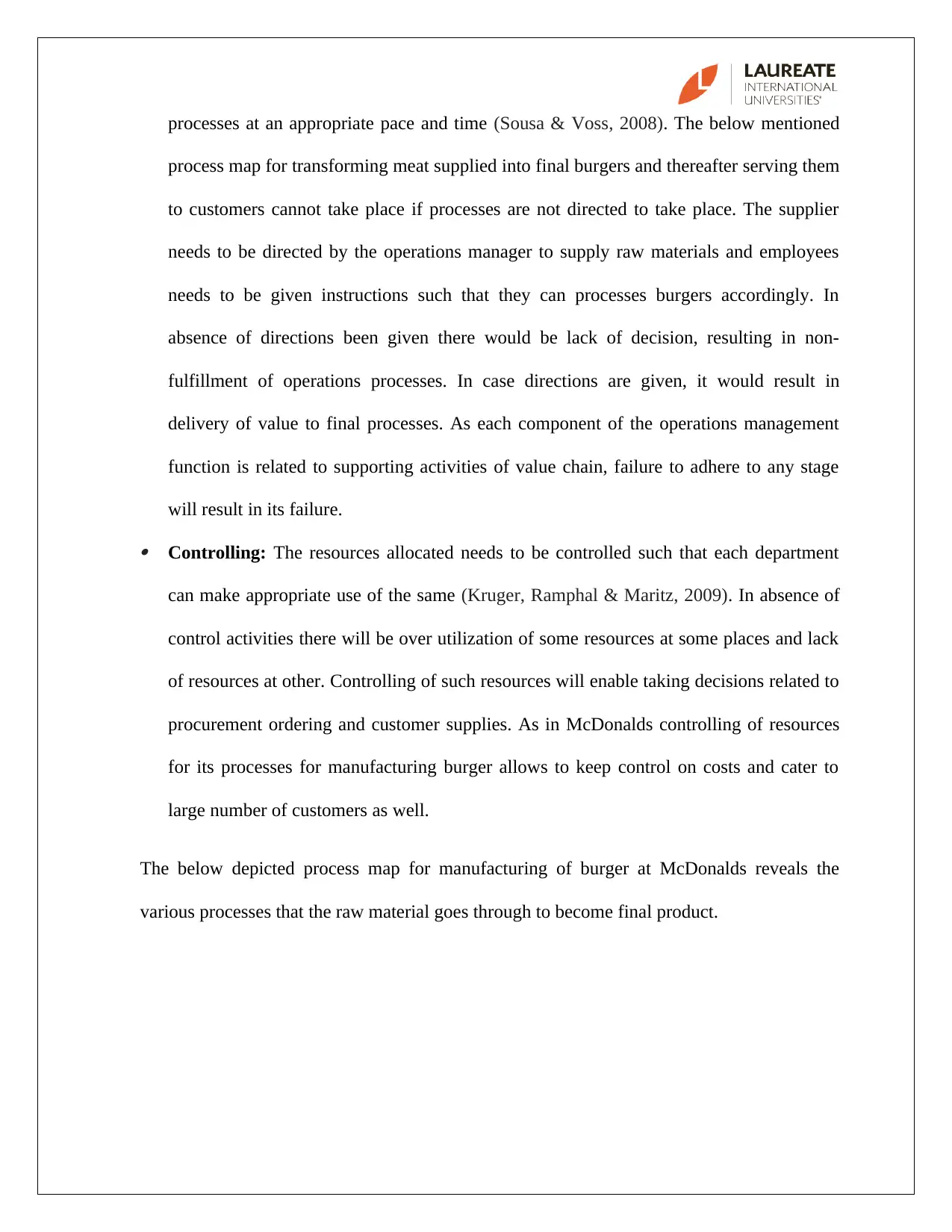
processes at an appropriate pace and time (Sousa & Voss, 2008). The below mentioned
process map for transforming meat supplied into final burgers and thereafter serving them
to customers cannot take place if processes are not directed to take place. The supplier
needs to be directed by the operations manager to supply raw materials and employees
needs to be given instructions such that they can processes burgers accordingly. In
absence of directions been given there would be lack of decision, resulting in non-
fulfillment of operations processes. In case directions are given, it would result in
delivery of value to final processes. As each component of the operations management
function is related to supporting activities of value chain, failure to adhere to any stage
will result in its failure. Controlling: The resources allocated needs to be controlled such that each department
can make appropriate use of the same (Kruger, Ramphal & Maritz, 2009). In absence of
control activities there will be over utilization of some resources at some places and lack
of resources at other. Controlling of such resources will enable taking decisions related to
procurement ordering and customer supplies. As in McDonalds controlling of resources
for its processes for manufacturing burger allows to keep control on costs and cater to
large number of customers as well.
The below depicted process map for manufacturing of burger at McDonalds reveals the
various processes that the raw material goes through to become final product.
process map for transforming meat supplied into final burgers and thereafter serving them
to customers cannot take place if processes are not directed to take place. The supplier
needs to be directed by the operations manager to supply raw materials and employees
needs to be given instructions such that they can processes burgers accordingly. In
absence of directions been given there would be lack of decision, resulting in non-
fulfillment of operations processes. In case directions are given, it would result in
delivery of value to final processes. As each component of the operations management
function is related to supporting activities of value chain, failure to adhere to any stage
will result in its failure. Controlling: The resources allocated needs to be controlled such that each department
can make appropriate use of the same (Kruger, Ramphal & Maritz, 2009). In absence of
control activities there will be over utilization of some resources at some places and lack
of resources at other. Controlling of such resources will enable taking decisions related to
procurement ordering and customer supplies. As in McDonalds controlling of resources
for its processes for manufacturing burger allows to keep control on costs and cater to
large number of customers as well.
The below depicted process map for manufacturing of burger at McDonalds reveals the
various processes that the raw material goes through to become final product.
⊘ This is a preview!⊘
Do you want full access?
Subscribe today to unlock all pages.

Trusted by 1+ million students worldwide
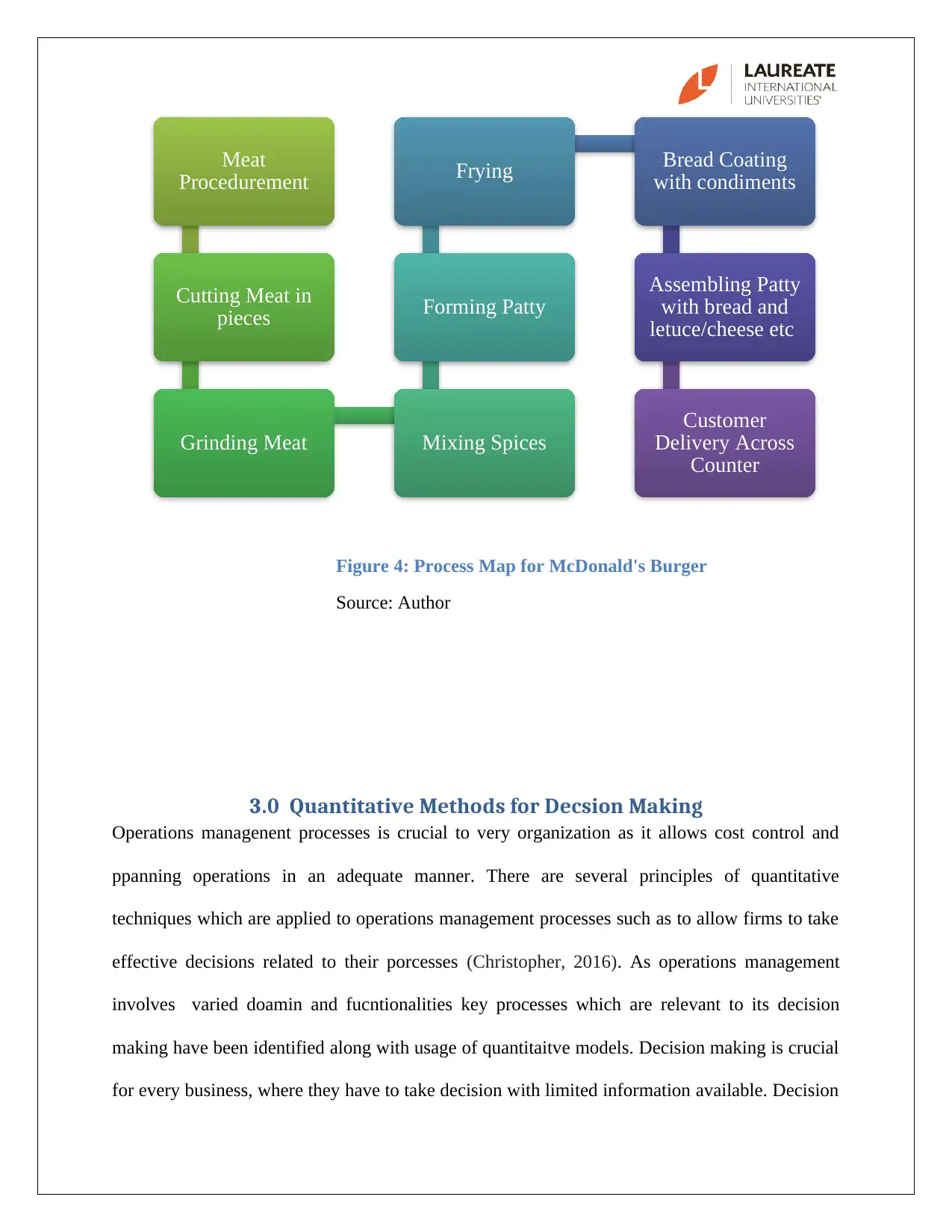
Figure 4: Process Map for McDonald's Burger
Source: Author
3.0 Quantitative Methods for Decsion Making
Operations managenent processes is crucial to very organization as it allows cost control and
ppanning operations in an adequate manner. There are several principles of quantitative
techniques which are applied to operations management processes such as to allow firms to take
effective decisions related to their porcesses (Christopher, 2016). As operations management
involves varied doamin and fucntionalities key processes which are relevant to its decision
making have been identified along with usage of quantitaitve models. Decision making is crucial
for every business, where they have to take decision with limited information available. Decision
Meat
Procedurement
Cutting Meat in
pieces
Grinding Meat Mixing Spices
Forming Patty
Frying Bread Coating
with condiments
Assembling Patty
with bread and
letuce/cheese etc
Customer
Delivery Across
Counter
Source: Author
3.0 Quantitative Methods for Decsion Making
Operations managenent processes is crucial to very organization as it allows cost control and
ppanning operations in an adequate manner. There are several principles of quantitative
techniques which are applied to operations management processes such as to allow firms to take
effective decisions related to their porcesses (Christopher, 2016). As operations management
involves varied doamin and fucntionalities key processes which are relevant to its decision
making have been identified along with usage of quantitaitve models. Decision making is crucial
for every business, where they have to take decision with limited information available. Decision
Meat
Procedurement
Cutting Meat in
pieces
Grinding Meat Mixing Spices
Forming Patty
Frying Bread Coating
with condiments
Assembling Patty
with bread and
letuce/cheese etc
Customer
Delivery Across
Counter
Paraphrase This Document
Need a fresh take? Get an instant paraphrase of this document with our AI Paraphraser
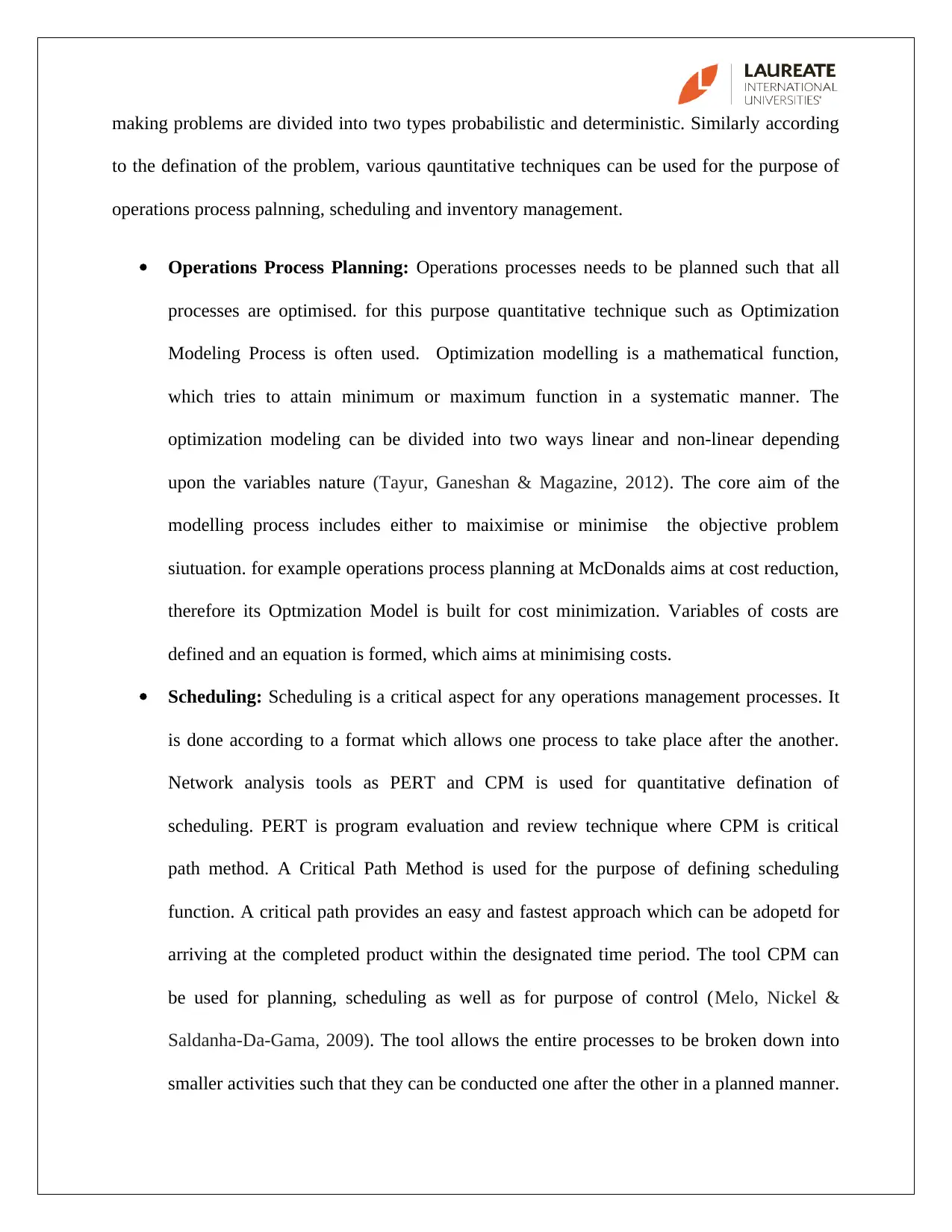
making problems are divided into two types probabilistic and deterministic. Similarly according
to the defination of the problem, various qauntitative techniques can be used for the purpose of
operations process palnning, scheduling and inventory management.
Operations Process Planning: Operations processes needs to be planned such that all
processes are optimised. for this purpose quantitative technique such as Optimization
Modeling Process is often used. Optimization modelling is a mathematical function,
which tries to attain minimum or maximum function in a systematic manner. The
optimization modeling can be divided into two ways linear and non-linear depending
upon the variables nature (Tayur, Ganeshan & Magazine, 2012). The core aim of the
modelling process includes either to maiximise or minimise the objective problem
siutuation. for example operations process planning at McDonalds aims at cost reduction,
therefore its Optmization Model is built for cost minimization. Variables of costs are
defined and an equation is formed, which aims at minimising costs.
Scheduling: Scheduling is a critical aspect for any operations management processes. It
is done according to a format which allows one process to take place after the another.
Network analysis tools as PERT and CPM is used for quantitative defination of
scheduling. PERT is program evaluation and review technique where CPM is critical
path method. A Critical Path Method is used for the purpose of defining scheduling
function. A critical path provides an easy and fastest approach which can be adopetd for
arriving at the completed product within the designated time period. The tool CPM can
be used for planning, scheduling as well as for purpose of control (Melo, Nickel &
Saldanha-Da-Gama, 2009). The tool allows the entire processes to be broken down into
smaller activities such that they can be conducted one after the other in a planned manner.
to the defination of the problem, various qauntitative techniques can be used for the purpose of
operations process palnning, scheduling and inventory management.
Operations Process Planning: Operations processes needs to be planned such that all
processes are optimised. for this purpose quantitative technique such as Optimization
Modeling Process is often used. Optimization modelling is a mathematical function,
which tries to attain minimum or maximum function in a systematic manner. The
optimization modeling can be divided into two ways linear and non-linear depending
upon the variables nature (Tayur, Ganeshan & Magazine, 2012). The core aim of the
modelling process includes either to maiximise or minimise the objective problem
siutuation. for example operations process planning at McDonalds aims at cost reduction,
therefore its Optmization Model is built for cost minimization. Variables of costs are
defined and an equation is formed, which aims at minimising costs.
Scheduling: Scheduling is a critical aspect for any operations management processes. It
is done according to a format which allows one process to take place after the another.
Network analysis tools as PERT and CPM is used for quantitative defination of
scheduling. PERT is program evaluation and review technique where CPM is critical
path method. A Critical Path Method is used for the purpose of defining scheduling
function. A critical path provides an easy and fastest approach which can be adopetd for
arriving at the completed product within the designated time period. The tool CPM can
be used for planning, scheduling as well as for purpose of control (Melo, Nickel &
Saldanha-Da-Gama, 2009). The tool allows the entire processes to be broken down into
smaller activities such that they can be conducted one after the other in a planned manner.
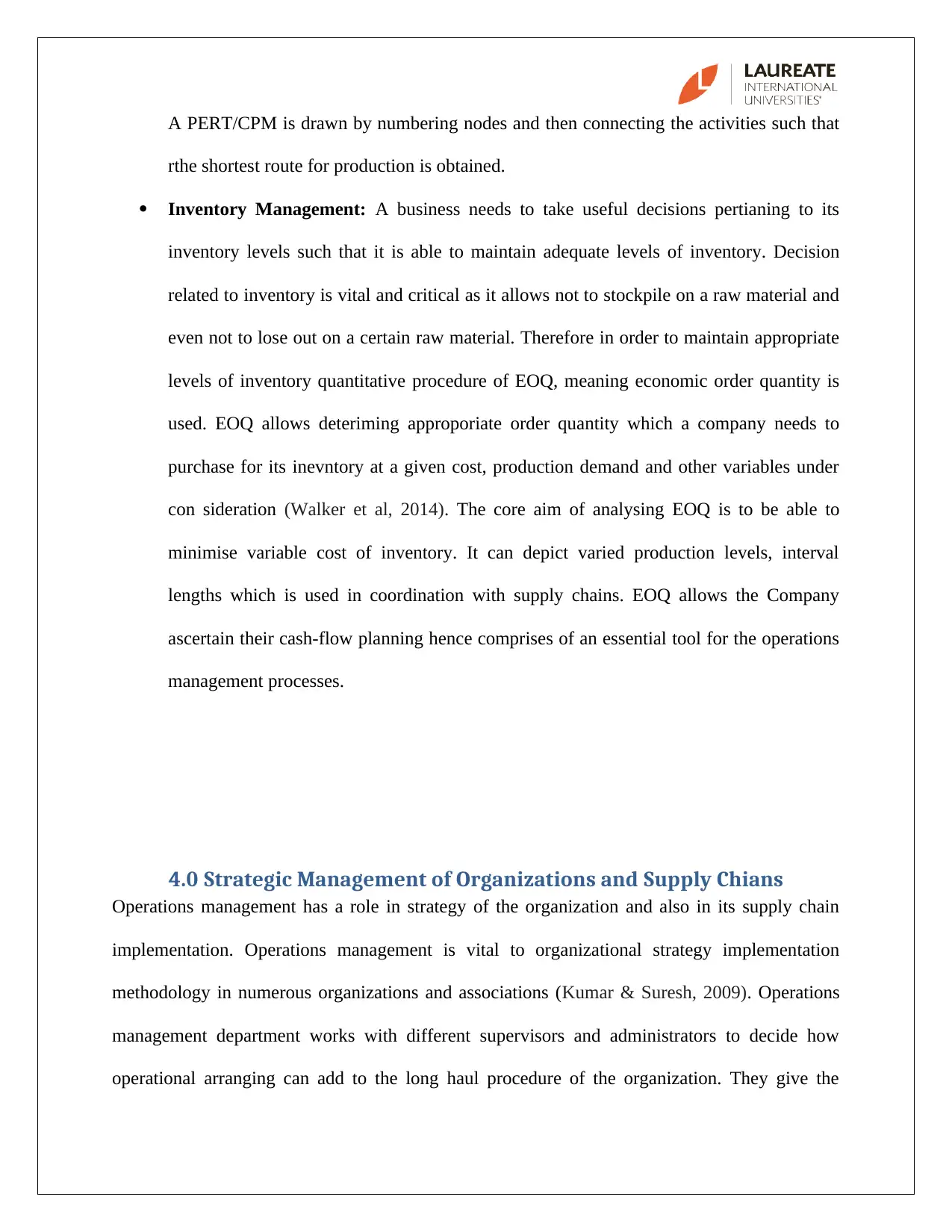
A PERT/CPM is drawn by numbering nodes and then connecting the activities such that
rthe shortest route for production is obtained.
Inventory Management: A business needs to take useful decisions pertianing to its
inventory levels such that it is able to maintain adequate levels of inventory. Decision
related to inventory is vital and critical as it allows not to stockpile on a raw material and
even not to lose out on a certain raw material. Therefore in order to maintain appropriate
levels of inventory quantitative procedure of EOQ, meaning economic order quantity is
used. EOQ allows deteriming approporiate order quantity which a company needs to
purchase for its inevntory at a given cost, production demand and other variables under
con sideration (Walker et al, 2014). The core aim of analysing EOQ is to be able to
minimise variable cost of inventory. It can depict varied production levels, interval
lengths which is used in coordination with supply chains. EOQ allows the Company
ascertain their cash-flow planning hence comprises of an essential tool for the operations
management processes.
4.0 Strategic Management of Organizations and Supply Chians
Operations management has a role in strategy of the organization and also in its supply chain
implementation. Operations management is vital to organizational strategy implementation
methodology in numerous organizations and associations (Kumar & Suresh, 2009). Operations
management department works with different supervisors and administrators to decide how
operational arranging can add to the long haul procedure of the organization. They give the
rthe shortest route for production is obtained.
Inventory Management: A business needs to take useful decisions pertianing to its
inventory levels such that it is able to maintain adequate levels of inventory. Decision
related to inventory is vital and critical as it allows not to stockpile on a raw material and
even not to lose out on a certain raw material. Therefore in order to maintain appropriate
levels of inventory quantitative procedure of EOQ, meaning economic order quantity is
used. EOQ allows deteriming approporiate order quantity which a company needs to
purchase for its inevntory at a given cost, production demand and other variables under
con sideration (Walker et al, 2014). The core aim of analysing EOQ is to be able to
minimise variable cost of inventory. It can depict varied production levels, interval
lengths which is used in coordination with supply chains. EOQ allows the Company
ascertain their cash-flow planning hence comprises of an essential tool for the operations
management processes.
4.0 Strategic Management of Organizations and Supply Chians
Operations management has a role in strategy of the organization and also in its supply chain
implementation. Operations management is vital to organizational strategy implementation
methodology in numerous organizations and associations (Kumar & Suresh, 2009). Operations
management department works with different supervisors and administrators to decide how
operational arranging can add to the long haul procedure of the organization. They give the
⊘ This is a preview!⊘
Do you want full access?
Subscribe today to unlock all pages.

Trusted by 1+ million students worldwide
1 out of 18
Related Documents
Your All-in-One AI-Powered Toolkit for Academic Success.
+13062052269
info@desklib.com
Available 24*7 on WhatsApp / Email
![[object Object]](/_next/static/media/star-bottom.7253800d.svg)
Unlock your academic potential
Copyright © 2020–2025 A2Z Services. All Rights Reserved. Developed and managed by ZUCOL.





